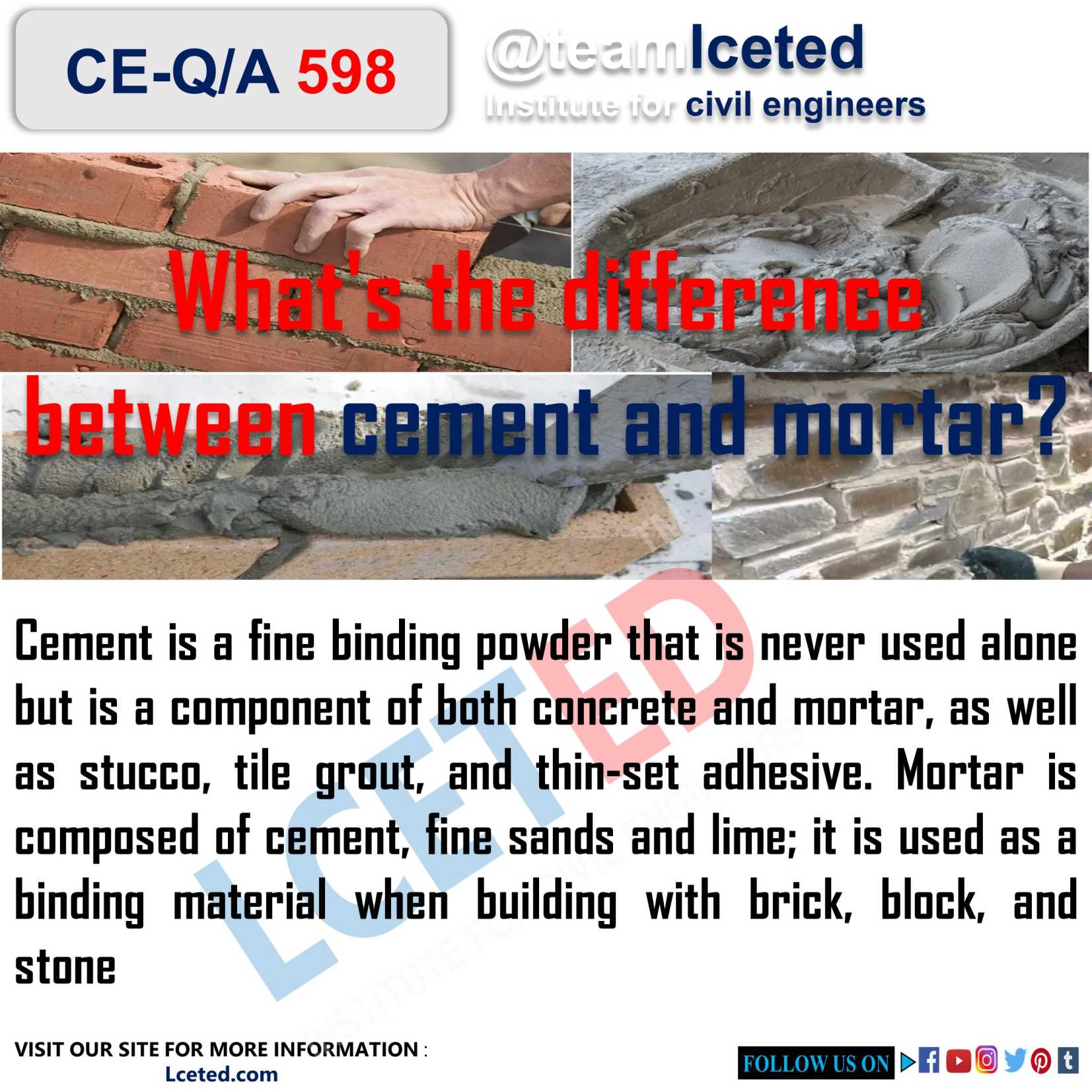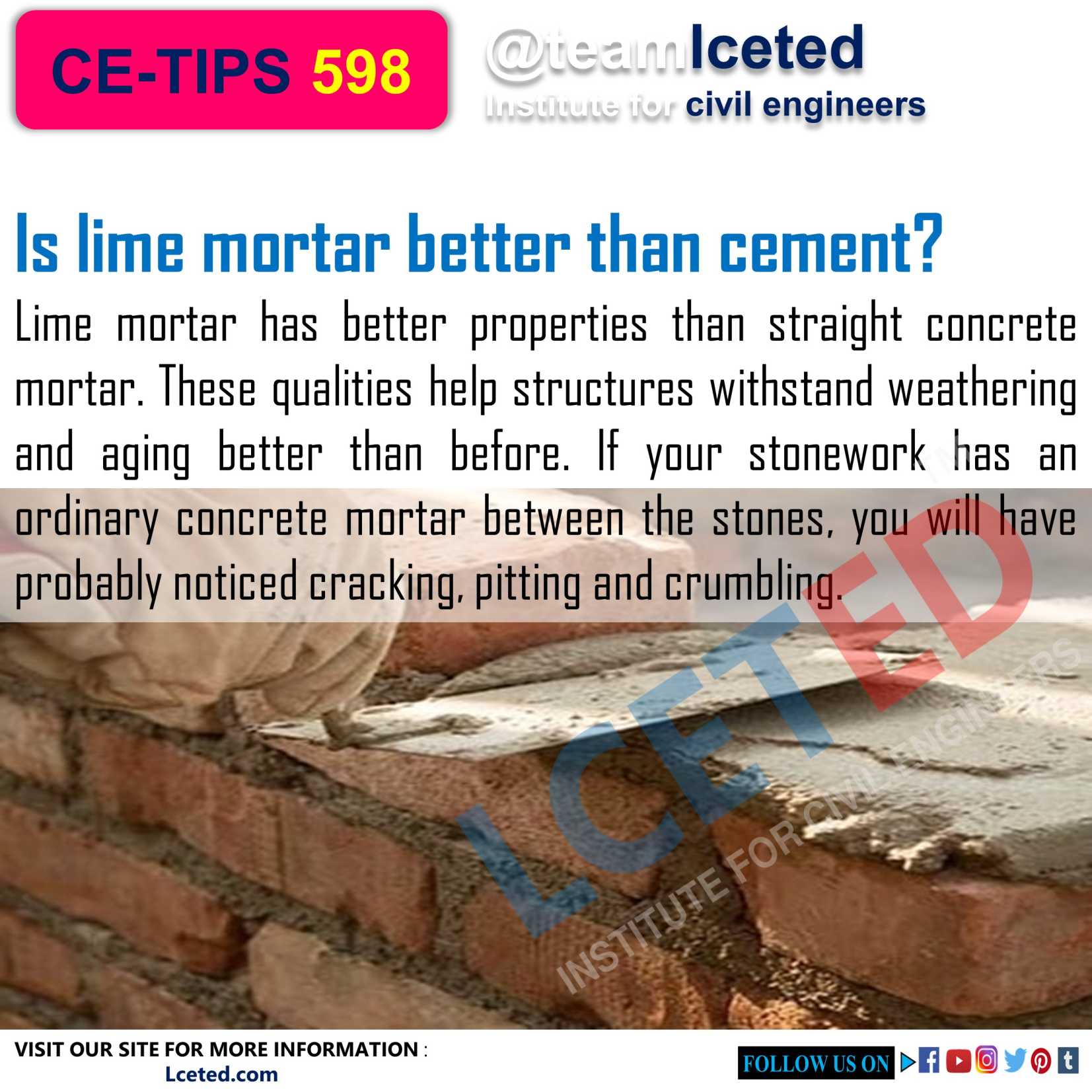WHAT IS MORTAR?
The term mortar is used to indicate a paste prepared by
adding a required quantity of water to a mixture of binding material like
cement or lime and fine aggregate like sand. This is used to bond masonry or
other structural units.
FUNCTIONS OF MORTAR
IN BUILDING WORKS
The
following are the major functions of mortar:
1. To bind building materials such as bricks and stones
into a solid mass.
2. To carry out pointing and plasterwork on exposed
surfaces of masonry.
3. To form an even and soft bedding layer for building
units.
4. To form joints of pipes.
5. To improve the general appearance of a structure.
6. To prepare moulds for coping, corbels, cornice, etc.
7. To serve as a matrix or cavity to hold the coarse
aggregates, etc.
8. To distribute uniformly the super-incumbent weight
from the upper layer to the lower layer of bricks or stones.
9. To hide the open joints of brickwork and stonework.
10. To fill up the cracks detected in the structure
during the maintenance process, etc.
TYPES OF MORTARS AND
THEIR PREPARATION
The following major types of mortars are recognized
based on the type of the cementing material used in its preparation: lime
mortars, cement mortars and gauged mortars are the most common types.
LIME MORTARS
Lime mortars are defined as mixes of lime with fine sand
and /or pozzolanic materials like surkhi, pumice, ash and cinder in water.
Preparation
The following are the main stages in the preparation of
lime mortars: selection of the raw materials, proportioning of the raw
materials and mixing of the raw materials.
Selection
of the raw materials
Lime, sand, surkhi, pumice, ash and cinder form the
major raw materials commonly used in the preparation of lime mortars.
Lime:
All types of lime can be used for making mortars, although all lime mortars
cannot be used for different situations. The main types of lime, namely the
fat lime and hydraulic lime, yield mortars of differ- ent qualities, the former
being suitable only for limited purposes like jointing and light loaded masonry
work whereas the latter being more useful in other situations as well. It is
essential that the lime to be used be free from impurities like silica, iron
oxide and, especially, gypsum.
Sand:
The sand for making a strong and durable mortar must be of good quality, i.e.,
it must be clean and sharp grained. The recommended fineness modulus of sand for
mortar is 2.00–3.00.
Sand
is added to the lime for at least two purposes:
i. To avoid shrinkage and cracking of mortar on
hardening because lime used alone shrinks and cracks on hardening.
ii. To increase the bulk of the mortar; this is
essential to make it more economical.
When used inappropriately
proportions, sand facilitates the hardening of the lime paste by yielding a
porous structure and allowing the atmospheric carbon dioxide access to the
inner lime.
Pozzolanic
materials: These include a variety of lightweight materials like
surkhi, cinder, pumice and ash, which have been found to increase the strength
of mortars when used in place of sand or even along with sand.
Water: In
general, water suitable for drinking purposes can be used in the preparation of
mortar. The water must be essentially free from alkalies, acids and organic
residues.
Sometimes, cement is also
added in small quantities to lime mortars to enhance the strength and setting
properties of mortar. Depending on the type of aggregate used, lime mortars
are further distinguished into lime–sand mortars, lime–surkhi mortars,
lime–sand–surkhi mortars and so on.
Proportioning
of the raw materials
The main aim of
proportioning is to fix such ratios of the raw materials that will result in a
mortar of desired quality, i.e., required strength, durability and finish. Since
the mortars used in different situations in construction are not subjected to
the same forces and conditions, no single rule for proportioning a mortar can
be framed. The widely recommended and commonly adopted proportions for different
conditions are summarized in Table.
Mixing
of the raw materials
It is of paramount
importance that the ingredients of mortar be mixed as thoroughly as possible.
Two common methods adopted are manual mixing and mortar mill mixing.
Manual
mixing: This is done on a watertight platform made of masonry
or in a tank of suitable dimensions. A spade is the main tool required.
Measured volumes of slaked lime and the aggregate are placed on the platform or
on the tank. These are first mixed in dry state by giving turns with the help of
the spade. Water is added gradually and mixing continued simultaneously until a
mortar of uniform consistency is obtained.
Mortar
mill mixing: A mortar mill is a mechanical device for
grinding the mortar ingredients in the presence of water and is run either by
animals or by power. In the traditional method, animal-driven mortar mills are
used.
Table:
Various Lime Mortar Compositions for Different Construction Works
|
Situation |
Mortar composition recommended |
Remarks |
|
(A) Foundations |
|
|
|
1. Foundation
concrete in dry subgrade with water level below 2.4 m of the foundation level |
Any
one of the following mixes: 1
lime, 2 sand 1
lime, 1 sand, 1 surkhi 1
lime, 2 surkhi 1
cement, 3 lime, 12 sand |
For
moist subgrade where water table is within 2.4 m of the foundation level,
only cement–sand mortar of 1:3 mix should be used for all foundation work |
|
2. Foundation
masonry with loading less than 4 tons/ ft2 |
1
lime, 2 sand 1
lime, 1 sand, 1 surkhi 1
lime, 2 surkhi 1
cement, 3 lime, 12 sand
|
|
|
3. Foundation
masonry in heavy and medium loading in dry subgrade |
1
cement, 1 lime, 6 sand |
|
|
(B)
Superstructures |
|
|
|
4. Load-bearing
walls with brick masonry. |
1
cement, 1 lime |
|
|
i)
Light loading |
1
lime, 1 sand, 1 surkhi 1 lime, 1 sand, 1 cinder |
Loading
less than 4 tons/ft2 |
|
ii)
Medium loading |
1
cement, 3 lime, 12 sand |
Loading
between 4 and 6 tons/ft2 |
|
iii)
Medium loading |
1
cement, 2 lime, 9 sand to 1 cement, 1 lime, 6 sand |
Loading
more than 8 tons/ft2 |
|
5. Non-load bearing partition wall with
concrete slabs or hollow blocks |
1
lime, 3 sand |
|
|
(C) Plasters |
|
|
|
6.
i) External plasters below damp proof course |
1
cement, 1 lime, 6 sand |
|
|
ii)
External plasters on all walls |
1
cement, 3 lime, 9 sand |
|
|
iii)
Internal plasters on all walls |
All
mixes are suitable |
|
|
General-purpose mortar |
1
cement, 1 lime, 6 sand |
Suitable
for most of masonry work and plasterwork |
Hardening
of lime mortars
Mortars made of fat lime or hydrated lime hardens by a the simple process of crystallization preceded by a loss of water due to
evaporation. The lime takes up the carbon dioxide from the atmosphere and forms
a crystal mass of calcium carbonate that is quite hard and responsible for the
strength of the mortar.
Cement mortar
The most common type of mortars of the present-day
generally consists of mixtures of cement with sand in the presence of a suitable
quantity of water. In all situations where a strong, durable and resistant
mortar is desired, the cement mortar becomes indispensable.
Table:
Proportions Recommended for Cement–Sand Mortar
|
Type and situation
of the work |
Recommended
proportions |
|
1. For
ordinary masonry work with bricks or stones as structural units. |
1
cement, 3 sand to 1 cement, 6 sand |
|
2. For
reinforced brickwork and for all work in moist situations. |
1
cement, 2 sand to 1 cement, 3 sand |
Preparation
The preparation of cement
mortar involves the same stages as lime mortar, namely selection of raw
materials, their proportioning and thorough mixing. Among the materials,
cement, sand and water are the essential ingredients. The cement used for preparing
mortar must be in perfectly undamaged and undeteriorated condition. Sand in
addition to possessing its usual properties must be free from impurities like
oxides of iron, clay and mica and must be thoroughly cleaned before being used
for good quality mortar. Generally, no other aggregate can replace sand
completely in a cement mortar, although nowadays several other alternatives are
being used. The functions of sand in the mortar include increasing the bulk of
the mortar, providing resistance against shrinkage and cracking on the setting
of cement and also making the mortar more strong.
Proportioning
Only very carefully proportioned volumes of the
ingredients are to be used in the preparation of cement mortars. The
proportioning is usually by volume. Different mix ratios are specified for
different works, the most commonly used are shown in Table
Mixing
of the ingredients
For small jobs, the manual
mixing of mortar is commonly practised and for large-scale construction where
larger batches of the mortar are required the mortar mill mixing is
indispensable.
Gauged
mortars
These mortars contain both
cement and lime as the essential ingredients besides the fine aggregate, which
is generally sand. The addition of cement to lime mortar improves considerably
the quality of mortar, especially in respect of its workability, time of the setting, hardening and ultimate strength.
Since the gauged mortars
consist of cement as one of the essential ingredients, it is important that
such mortars are consumed within 2 hours of their preparation to avoid any
deterioration in quality.
If you find
This information helpful, please share it.
Thanks! For reading the article.










No comments:
Post a Comment